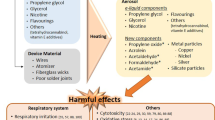Abstract
The exhaled breath temperature (EBT) has been proven to be the expression of airways inflammation as well as of the increased vascularity. Although both these conditions characterize lung cancer pathogenesis, this is the first study where the EBT has been analysed in patients affected by non-small-cell lung cancer. The aim of this study was to verify whether and how the lung cancer being examined influences the EBT for possible future clinical implications. Eighty-two consecutive subjects with a radiological suspicion of lung cancer were enrolled and underwent standard diagnostic and staging procedures for cancer. EBT was measured in all the subjects at the enrolment with the X-Halo device. Forty patients resulted as affected by lung cancer while 42 as false-positive (controls). We found a higher EBT in NSCLC patients compared to healthy subjects. The EBT was correlated with number of packs/year and associated with the stage of lung cancer. We identified a cut-off value for the EBT that is able to screen patients with lung cancer with a high sensitivity and specificity. Our results suggest that lung cancer causes an increase in the EBT, which, whether confirmed and validated, could become a new non-invasive clinical tool in the screening and monitoring of this disease.

Similar content being viewed by others
References
Carpagnano GE, Palladino GP, Lacedonia D, Koutelou A, Orlando S, Foschino-Barbaro MP. Neutrophilic airways inflammation in lung cancer: the role of exhaled LTB-4 and IL-8. BMC Cancer. 2011;11:226.
Paredi P, Kharitonov SA, Barnes PJ. Correlation of exhaled breath temperature with bronchial blood flow in asthma. Respir Res. 2005;6:15.
Macchiarini P, Fontanini G, Squartini F, Angeletti CA, Hardin MJ. Relation of neovascularisation to metastasis of non-small-cell lung cancer. Lancet. 1992;340(8812):145–6.
Folkman J. What is the evidence that tumours are angiogenesis dependent? J Natl Cancer Inst. 1990;82:4–6.
Popov TA, Kralimarkova TZ, Lazarova CT, Tzachev CT, Dimitrov VD, Gill J. Daily monitoring of asthmatics by means of individual devices for exhaled breath temperature measurement. IEEE Sens J. 2010;10(1):44–8.
Edell SI, Eisen MD. Current imaging modalities for the diagnosis of breast cancer. Del Med. 1999;71:377–82.
Piacentini GL, Peroni DG, Bodini A, Corradi M, Boner AL. Exhaled breath temperature as a marker of airway remodelling in asthma—a preliminary study. Allergy. 2008;1:484–5.
Stefanadis C, Chrysohoou C, Panagiotakos DB, Passalidou E, Katsi V, Polychronopoulos V, Toutouzas PK. Temperature differences are associated with malignancy on lung lesions: a clinical study. BMC Cancer. 2003;3:1.
Melo RE, Popov TA, Solé D. Exhaled breath temperature, a new biomarker in asthma control: a pilot study. J Bras Pneumol. 2010;36(6):693–9.
Peroni DG, Chinellato I, Piazza M, Zardini F, Bodini A, Olivieri F, Boner AL, Piacentini GL. Exhaled breath temperature and exercise-induced bronchoconstriction in asthmatic children. Pediatr Pulmonol. 2012;47(3):240–4.
Popov TA, Dunev S, Kralimarkova TZ, Kraeva S, DuBuske LM. Evaluation of a simple, potentially individual device for exhaled breath temperature measurement. Respir Med. 2007;101:2044–50.
Xepapadaki P, Xatziioannou A, Chatzicharalambous M, Makrinioti H, Papadopoulos NG. Exhaled breath temperature increases during mild exacerbations in children with virus-induced asthma. Int Arch Allergy Immunol. 2010;153:70–4.
Popov TA, Kralimarkova T, Tzachev C, Dimitrov V, Mun KK, Gill J. Exhaled breath temperature measurement made easy. Pediatr Allergy Immunol. 2009;20:200–1.
Paruch M, Majchrzak E. Identification of tumor region parameters using evolutionary algorithm and multiple reciprocity boundary element method. Eng Appl Artif Intell. 2007;20:647–55.
Mittal M, Pidaparti RM. Breast tumor simulation and parameters estimation using evolutionary algorithm. Modell Simul Eng. 2008;Article I:756436-41.
Umadevi V, Raghavan SV, Jaipurkar S. Framework for estimating tumour parameters using thermal imaging. Indian J Med Res. 2011;134(5):725–31.
Herman C, Cetingul MP. Quantitative visualization and detection of skin cancer using dynamic thermal imaging. J Vis Exp. 2011;5(51):1–3.
Piacentini GL, Bodini A, Zerman L, Costella S, Zanolla L, Peroni DG, Boner AL. Relationship between exhaled air temperature and exhaled nitric oxide in childhood asthma. Eur Respir J. 2002;20:108–11.
Paredi P, Kharitonov SA, Barnes PJ. Faster rise of exhaled breath temperature in asthma: a novel marker of airway inflammation? Am J Respir Crit Care Med. 2002;165:181–4.
Popov TA, Kralimarkova TZ, Tzachev CT, Dunev SS, Dimitrov VD, Gill J. Development of an individual device for exhaled breath temperature measurement. IEEE Sens J. 2010;10(1):110–3.
Carraro S, Piacentini G, Lusiani M, Uyan ZS, Filippone M, Schiavon M, Boner AL, Baraldi E. Exhaled air temperature in children with bronchopulmonary dysplasia. Pediatr Pulmonol. 2010;45:1240–5.
Paredi P, Caramori G, Cramer D, Ward S, Ciaccia A, Papi A, Kharitonov SA, Barnes PJ. Slower rise of exhaled breath temperature in chronic obstructive pulmonary disease. Eur Respir J. 2003;21:439–43.
Conflict of interest
The authors declare that they have no conflict of interest.
Ethical standard
Written informed consent was obtained from all the subjects upon approval of the study by the Ethic Committees of the two hospitals.
Author information
Authors and Affiliations
Corresponding author
Rights and permissions
About this article
Cite this article
Carpagnano, G.E., Lacedonia, D., Spanevello, A. et al. Exhaled breath temperature in NSCLC: Could be a new non-invasive marker?. Med Oncol 31, 952 (2014). https://doi.org/10.1007/s12032-014-0952-1
Received:
Accepted:
Published:
DOI: https://doi.org/10.1007/s12032-014-0952-1




